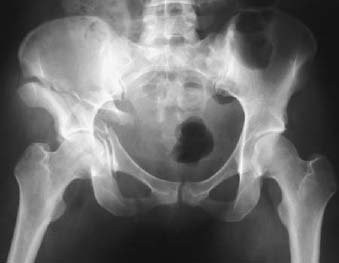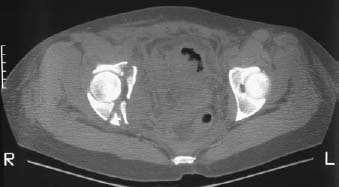CASE 82 Anthony G. Ryan and Peter L. Munk An unconscious 24-year-old woman presented after a high-velocity motor vehicle impact. The driver of the vehicle was found dead at the scene. The patient had been an unrestrained front-seat passenger, had been expelled from the vehicle, and was found by the ambulance personnel with the lower half of her body trapped beneath the vehicle. Figure 82A A plain film of the pelvis (Fig. 82A) performed as part of the initial examination shows multiple fractures of the right pelvic rings, including the superior and inferior pubic rami and diastasis of the right sacroiliac joint (the right iliac wing is seen completely en face). There is a complete transverse fracture of the iliac wing exiting between the anterior superior and inferior iliac spines. A butterfly fragment in relation to this fracture is present, displaced centrally. Both the iliopectineal and ilioischial lines are disrupted. Combined modality pelvic fracture (AP compression predominant) with severe complex acetabular fracture. The plain film shows a severely comminuted fracture involving the anterior and posterior columns, evinced by disruption of both iliopectineal and ilioischial lines. The acetabular articular surface is split at its apex. Concomitant transaxial CT at the level of the acetabulum (Fig. 82B) confirms the fractures of the anterior and posterior columns, with a further infratectal transverse component (running in the AP direction and caudad to the larger transverse fracture seen on the plain film). In addition to the posterior column fracture, the posterior wall of the acetabulum is fractured. A breach of the quadrilateral plate is seen as well, with an associated pelvic side wall hematoma. None. Acetabular fractures are relatively common, comprising 25% of all pelvic fractures, with fractures of the acetabular wall most common. Given its weight-bearing function, the most clinically important part of the acetabulum is the roof, formed and supported by the anterior and posterior columns, which meet to form an inverted Y with a 60-degree angle between the divergent limbs. Fractures involving the roof, one or both columns, or any combination of the above will be discussed below. These fractures occur as a result of high-energy trauma, for example, secondary to high-speed motor vehicle accident or a fall/jump from a great height, as in an attempted suicide or an unopened parachute accident. The mechanism of injury frequently results in complex fractures with comminution and components in multiple planes. Fractures disrupting the acetabular articular surface result in two fundamental injuries: to the articular cartilage and to the supporting skeleton of the joint. Cartilage injury may result in alteration of the proteoglycan matrix and in some cases can cause chondrocyte death, leading to further degeneration of the articular surface in addition to the focal direct cartilaginous trauma experienced. Unreduced or malaligned fractures result in articular surface irregularity secondary to the osseous disruption and concomitant cartilaginous destruction, which in turn causes significant increases in peak contact pressures, the latter promoting the development of degenerative arthritic changes. These fractures are found predominantly in young male patients involved in incidents as described above. They are frequently in hemorrhagic shock on arrival at the emergency room. If there is a concomitant hip dislocation, the affected leg will be in internal rotation. Accompanying sciatic nerve injury is indicated by paresis of the hamstrings and forelimb muscles and by paresthesias of the foot. Acetabular fractures are often complex, with multiple fragments and secondary fracture lines. Four injury patterns make up 75% of all acetabular fractures: posterior wall, transverse, combined transverse, and posterior wall and fractures of both columns. The use of the classification system devised by Judet in 1964 and modified by Letournel in 1980 led to improved management of such injuries. Fractures are divided into two main types: elementary, which consist of injuries to a single structural component, and associated, which are combinations of the elementary types. The five elementary fracture types are The five associated fracture types, which involve a combination of the elementary entities, are The individual fractures and their combinations are considered in more detail below. A posterior acetabular wall fracture is typically caused by the impact on the knee of a flexed, abducted hip against the dashboard in a motor vehicle accident. The size of the resultant fracture is directly proportional to the degree of abduction of the hip. The greater the degree to which the hip is flexed, the more inferior the fracture will be located on the acetabular rim. If displaced, the fragment is usually driven posteriorly; however, posterior marginal impaction can occur, which is more difficult to diagnose. If unrecognized preoperatively, this will limit the success of reduction and fixation. Transverse fracture of the acetabulum, as the name implies, bisects the joint in the transaxial plane, dividing the hemipelvis into two halves: inferior (which is also usually anterior) and superior. The fracture is rarely truly transverse, with a tendency to angulation in the craniocaudal direction, higher medially than laterally. On transaxial CT slices, the fracture line may thus be seen to follow a lateral course from above inferiorly, which may be confused for a vertically oriented fracture. Multiple plane radiographs or multiplanar reformats of CT data may be required to establish the orientation. Transverse fractures may be further subclassified by virtue of their exact relationship with the acetabular roof: juxtatectal, transtectal, or infratectal. Infratectal fractures cross below the level of the acetabular roof. The transtectal transverse fracture line crosses the roof of the articular surface, whereas the juxtatectal fracture line crosses the acetabulum at the junction of the roof of the acetabulum and the cotyloid fossa, which, while not disrupting the articular surface directly, may give rise to secondary surface irregularity.
Acetabular Fractures
Clinical Presentation

Radiologic Findings
Diagnosis

Differential Diagnosis
Discussion
Background
Etiology
Pathophysiology
Clinical Findings
Stages of Disease
ELEMENTARY FRACTURES
Posterior acetabular wall fracture
Transverse acetabular fracture
Anterior column fracture
Stay updated, free articles. Join our Telegram channel

Full access? Get Clinical Tree


